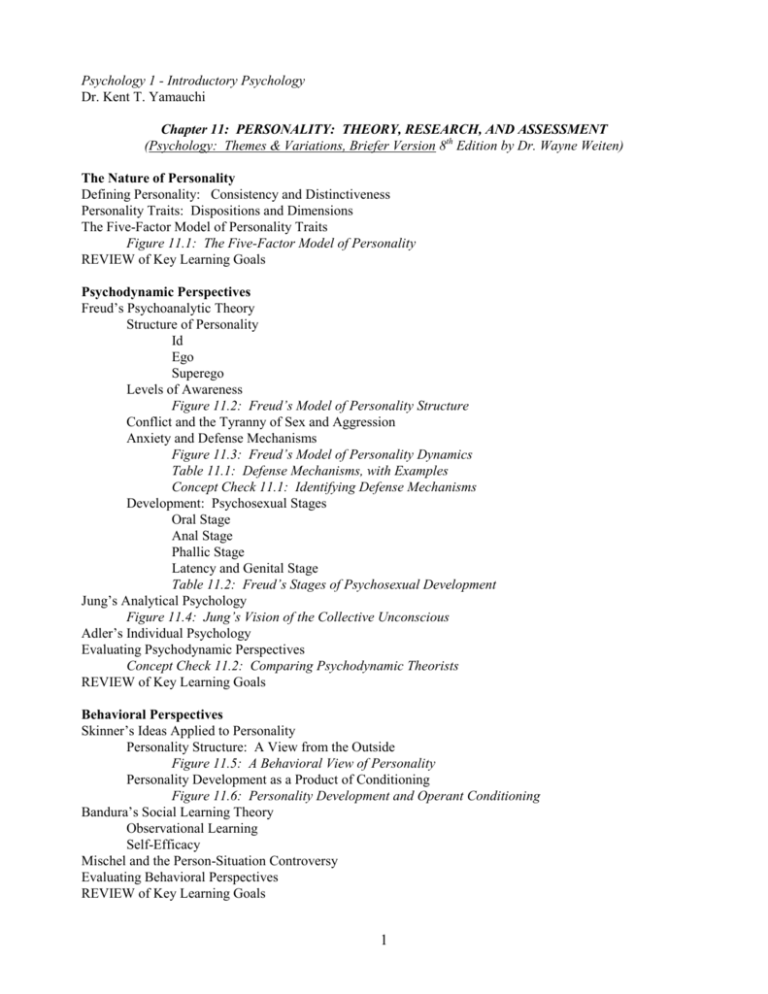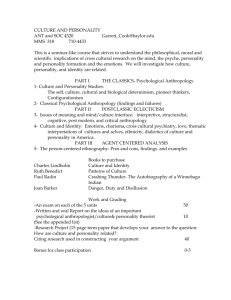Personality
advertisement

Psychology 1 - Introductory Psychology Dr. Kent T. Yamauchi Chapter 11: PERSONALITY: THEORY, RESEARCH, AND ASSESSMENT (Psychology: Themes & Variations, Briefer Version 8th Edition by Dr. Wayne Weiten) The Nature of Personality Defining Personality: Consistency and Distinctiveness Personality Traits: Dispositions and Dimensions The Five-Factor Model of Personality Traits Figure 11.1: The Five-Factor Model of Personality REVIEW of Key Learning Goals Psychodynamic Perspectives Freud’s Psychoanalytic Theory Structure of Personality Id Ego Superego Levels of Awareness Figure 11.2: Freud’s Model of Personality Structure Conflict and the Tyranny of Sex and Aggression Anxiety and Defense Mechanisms Figure 11.3: Freud’s Model of Personality Dynamics Table 11.1: Defense Mechanisms, with Examples Concept Check 11.1: Identifying Defense Mechanisms Development: Psychosexual Stages Oral Stage Anal Stage Phallic Stage Latency and Genital Stage Table 11.2: Freud’s Stages of Psychosexual Development Jung’s Analytical Psychology Figure 11.4: Jung’s Vision of the Collective Unconscious Adler’s Individual Psychology Evaluating Psychodynamic Perspectives Concept Check 11.2: Comparing Psychodynamic Theorists REVIEW of Key Learning Goals Behavioral Perspectives Skinner’s Ideas Applied to Personality Personality Structure: A View from the Outside Figure 11.5: A Behavioral View of Personality Personality Development as a Product of Conditioning Figure 11.6: Personality Development and Operant Conditioning Bandura’s Social Learning Theory Observational Learning Self-Efficacy Mischel and the Person-Situation Controversy Evaluating Behavioral Perspectives REVIEW of Key Learning Goals 1 Humanistic Perspectives Roger’s Person-Centered Theory The Self Figure 11.7: Roger’s View of Personality Structure Development of the Self Anxiety and Defense Figure 11.8: Roger’s View of Personality Development and Dynamics Maslow’s Theory of Self-Actualization Hierarchy of Needs Figure 11.9: Maslow’s Hierarchy of Needs The Healthy Personality Figure 11.10: Maslow’s View of the Healthy Personality Evaluating Humanistic Perspectives Concept Check 11.3: Recognizing Key Concepts in Personality Theories REVIEW of Key Learning Goals Biological Perspectives Eysenck’s Theory Figure 11.11: Eysenck’s Model of Personality Structure Behavioral Genetics and Personality Figure 11.12: Twin Studies of Personality The Evolutionary Approach to Personality Evaluating Biological Perspectives REVIEW of Key Learning Goals Concept check 11.4: Understanding the Implications of Major Theories: Who Said This? A Contemporary Empirical Approach: Terror management Theory Essentials of Terror Management Theory Figure 11.13: Overview of Terror Management Theory Applications of Terror Management Theory REIVEW of Key Leaning Goals Illustrated Overview of Major Theories of Personality (pages 400-401) Culture and Personality Figure 11.14: An Example of Inaccurate Perceptions of National Character Figure 11.15: Culture and Conceptions of Self REVIEW of Key Learning Goals Concept Check 11.5: Identifying the Contributions of Major Theorists and Researchers Reflecting on the Chapter’s Themes REVIEW of Key Learning Goals Personal Application: Understanding Personality Assessment Self-Report Inventories The MMPI Figure 11.16: MMPI Profiles The 16PF and NEO Personality Inventory Figure 11.17: The Sixteen Personality Factor Questionnaire Strengths and Weaknesses of Self-Report Inventories Projective Tests Figure 11.18: The Thematic Apperception Test 2 The Projective Hypothesis Strengths and Weaknesses Personality Testing on the Internet REVIEW of Key Learning Goals Critical Thinking: Hindsight in Everyday Analyses of Personality The Prevalence of Hindsight Bias Hindsight and Personality Other Implications of “20-20 Hindsight” Concept Check 11.3: Critical Thinking Skill Discussed in this Application REVIEW of Key Learning Goals Chapter 11 Recap Chapter 11 Practice Test Psych 1 Ch 11 Outline - Weiten 8th Edition 3









